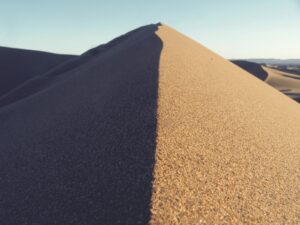Subscribe to the Newsletter
If you are interested in understanding how Traditional Chinese Medicine can improve your life sign up to my newsletter for the latest updates.

Clogstoun Congee nourishes your Stomach, especially your Stomach Yin energy, which feeds and hydrates you.
That’s vital because your Lungs need that moisture to combat all the dryness in the air (offices, air-conditioning, central heating) and in many of our foods (ranging from dried fruit to toast).
With good hydration your immunity improves.
Answer: because water flushes you out and often isn’t absorbed properly which then means you end up peeing lots without retaining what you need.
Clogstoun Congee, on the other hand, is made so that the grain (usually organic, long-grain, white rice) absorbs more and more water.
When eaten, it gives that water up only slowly, allowing your body to assimilate it properly.
Instead of being, as it were, sidelined straight to your kidneys, it enters your Liver and is turned into Blood. It then does the rounds, feeding and replenishing your body, artery to capillary to vein.
On its return to the centre it brings along the garbage and what is not excreted returns into the system. So, in the form of Blood, it goes to repair and fill out flesh. ‘Hydration’!
This increases the Yin fluids in your body. That has a stabilising effect on your Yang energy. So you feel calmer, less prone to anxiety, to snacking, to hunger. That puts you in better control of your weight and less easily swayed by fads. Less Yin deficient!
You become steadier in yourself. That helps sleep. That in turn improves your health and reserves which then makes you less susceptible to hazards like coughs, colds and other diseases.
And all because you changed your eating habits!
(By the way … at the very foot of this page, see lot’s of interesting and good questions which I’ve tried to answer.)
No! Does just one cup of coffee keep you awake forever?
Obviously not!
Your body needs regular nourishment. You can damage it over time with a bad diet. You can mend it over time with a good diet.
If you take Clogstoun Congee regularly, you’ll be amazed how much fitter you become. (But do remember, Clogstoun Congee is only part of the nutrition your body needs. You’ll also need other foods. See Nutrition.)

Almost any grain can be used, and I’ll add pages on them in due course, but let’s start with the basic: organically grown, long-grain white rice.
By the way, it’s mostly grown in and exported from California. The Chinese don’t export that much rice.

Believe it or not, 1 uncooked cup of this rice will make enough Clogstoun Congee for at least three or four people!
You’ll need the pot of boiling filtered water nearby, and a largish, flat-bottomed stock pot. In the picture you’ll see a Creuzet pot, but don’t get hooked on this! The pot should have a thick bottom.



Once it’s done, it will be a semi-fluid rice porridge. See picture. If the rice looks dry, you need more water. (The presence of the milky like fluid is important… Oh! I might have said that before…!)

Take your pick of the following to eat with it:
Each of these foods has a different ‘energetic’ effect and if you know your constitution well you may be able to choose the particular add-ins to suit yourself that day. (‘Energetic’? Yes, foods have energetic effects quite apart from the temperature at which you serve them. Read more under Nutrition, Hot foods and Cold foods.)
But variety is best. Don’t have the same thing every day. You intestines contain trillions of organisms, mostly good if you are healthy, and they benefit from a varied diet.

The less healthy you are, the simpler the dish. If you are a convalescent, or have just suffered a shock, or have a very weak digestion, have the Clogstoun Congee on its own until you feel stronger, maybe adding a thin slice of ginger as you stir in water.
For someone gravely ill, it might be all he or she eats to start with.
Each of the foods above benefits a particular organ. The grain itself and the proteins benefit your Stomach and Spleen. Toasted sesame oil helps to consolidate your Kidney energy; sauerkraut is more for your Liver and Gallbladder.
You can take it daily! Or three times a week or … ! It’s up to you.
But if you are trying to regain health, take it daily if possible.
You can also make it with other grains, like oats (Clogstoun Porridgee), millet, even wheat. We’ll have pages on those in due course.
Milk is a good food, when you need it. But it is very moistening and can lead to the build-up of Damp or Phlegm.
So if you have a very sore, dry throat, some milk added – in the last stages of preparing Clogstoun Congee – might greatly ease the pain.

Stay in Touch!
No spam, only notifications about new articles and updates.

Book a Video consultation if you want to know more about your symptoms

This Introductory Chinese medicine course introduces you to the amazing thinking behind this ancient medicine, now increasingly in demand.

The Scottish College for Chinese medicine provides introductory courses for all, explaining Chinese medicine and its cultural background.

Master Tung’s acupuncture is a hidden treasure, lost to China but recovered in Taiwan from where it spread round the world.

Knee pain has five main causes. It’s certainly worth trying acupuncture before you resort to surgery!
Subscribe to the Newsletter
If you are interested in understanding how Traditional Chinese Medicine can improve your life sign up to my newsletter for the latest updates.
Subscribe to the Newsletter
If you are interested in understanding how Traditional Chinese Medicine can improve your life sign up to my newsletter for the latest updates.
11 Responses
Hi there! Thank you so much for this recipe. Can you heat up the leftovers the next day or is it best had fresh?
Because of possible fungal and other problems, the official safe line is to not heat up leftover rice dishes from yesterday. But, if I’m doing it, yes I do, but only the day after and only if I’ve been sure to refridgerate the leftovers meantime: even then I’d smell and examine it carefully before re-using it!
However, in warm countries, if the unused rice dish is left out overnight, I doubt if I’d risk it.
So freshly-made is best!
Two comments, first adding protein to rice is number one no-no for proper food combining (consult your TCM food combining chart). This could make a person sicker than they began. Two, by cooking rice and then cooling it changes its molecular structure and changes its fiber to resistant starch which is beneficial for the bacteria in the intestines and good for body cells. It’s also easier to digest and lower in calories but the rice can NOT be reheated when eaten. Interested in your feedback.
Thanks SunnyCO for your contribution. You’re right that food combining frowns on combining protein and rice, but this doesn’t matter for many: their digestions cope all right. As to re-heating rice, I agree it’s not good practice but again, for many it is not a problem. Thaks again. Jonathan
We just started eating congee. My question is how much & how often? Should it be consumed for 1 meal per day? We’ve been eating it for a week now. I feel clear, more focused, more energy. Hubby the same. However his sugar level went up 10 points & he felt an ache in his kidney this morning. So perhaps we should eat less of it? I make it with bone broth & various veggies. Is it usually a cup a day? Thank you.
Though excellent in many ways, congee does not claim to be a complete food. Because of its rice content, it is predominantly a ‘sweet’ type food. Unless you take, with it or in it, or at other meals, foods categorised by other tastes, you are not getting complete nutrition: same from the Western viewpoint. But a cup, even two, daily, sounds good.
Concerning your husband’s sugar level, this might be because congee is, as I say, sweet so his body is absorbing more sugars (as carbohydrate). From a five element point of view (see https://www.acupuncture-points.org/5-elements-acupuncture.html) Earth regulates Water, so if Earth is out of balance, Kidney and Bladder qi may behave strangely. However, if he’s only been eating congee for a week and there are no other obvious causes, I wouldn’t worry unless the pain continues to worsen day by day: the change may just be his body making changes in how it works. If so, his morning kidney ache (and sugar levels) should gradually improve, particularly if in other ways, overall, he is feeling better.
Hope this helps.
This is so interesting, thank you for the great information! I’m curious if there’s a way to make this in smaller batches so a single person can have it fresh without ending up with too much to eat in a single day.
Fresh is best, so make smaller amounts to suit yourself. Just be aware that using less rice etc means it will dry out faster so you need to add water more frequently and in smaller amounts, while continuing to stir. Also, use a pot with a thick bottom.
Many thanks, Jonathan, for this detailed recipe which I’ve just made. I really appreciate the detailed information (not just in this recipe but your whole site which I often refer to!). I have the same question as Jennifer above. What do you think about the idea of freezing small portions of the congee straight after making it? I have a good 4 portions but maybe eating it twice a day for 2 days isn’t ideal?
Yes, good idea, but aren’t we lucky these modern times to have the ability to freeze foods quickly?!
So don’t do it if you’ve left the cooked congee to cool on the side for a while. Freeze it quick after cooking it, so those little and potentially unpleasant fungi don’t get time to infiltrate it.
And when heating, do it as fast as possible: here’s where a microwave seems a good idea, though I’ve no idea what the ancient Chinese might have considered long-term use of microwave heating to be. I doubt the energetic effect of microwave heating is quite the same as heating over fire, let alone over heated electric elements: possibly more drying than heating, which may be why some microwave recipes suggest we first add some water? Don’t know.
Hi Jonathan, thank you very much for your reply. I kept forgetting to check back so apologies for my late response. I much appreciate the thought-provoking ideas and I’ll make sure to freeze it right away.